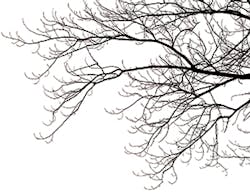Editor’s Comments: The Long-Term Forecast and the New Normal
In november, the US Forest Service released the results of its latest aerial survey of California’s forest lands, which showed that the state now has approximately 102 million dead trees, victims of the ongoing drought. The increasing rate of decline is particularly alarming: about 62 million trees died in 2016, 36 million of them since the previous survey in May.
In the near term, the massive amount of dead wood means more fuel for wildfires; officials say we can expect more of them, and hotter-burning ones. One state fire official describes the hard soil crust created by a very hot fire as “like a sheet of glass” that funnels water downhill, exacerbating erosion problems and the potential for mudslides.
This is something California and, to an extent, other drought-stricken states will be dealing with for years. Even if rainfall returns to pre-drought levels, the Forest Service says, trees will continue to die for a year or more, now that so many are weakened and more susceptible to other problems like beetle infestations. Agriculture Secretary Tom Vilsack points out that states also face a tough budgetary choice, as money intended for removing dead trees—which would lessen the risk of wildfire—must often be diverted to fight fires that are already ongoing.
In the long term, however, these might be among the least of our problems. Scientists continue to predict megadroughts for the US Southwest. These decades-long droughts were thought to occur perhaps once or twice in a thousand years; researchers from NASA’s Goddard Institute, Columbia University, and elsewhere now say we’re almost certain to experience one this century.
A megadrought around AD 1200 in what’s now the Southwestern US is believed to have caused the disappearance of several Native American cultures that had flourished for centuries. But by the time the Spanish arrived, and continuing on into the 1800s, the same ground was again lush and fertile. Despite at least two long periods of drought since then, we continue to think of the wetter conditions and productive soil as the more normal circumstance.
The same pattern has occurred elsewhere around the globe. For example, Greenland experienced an uncharacteristic warm period from about AD 950 to 1250. It was a localized, not a global, change, perhaps caused by volcanic activity or altered ocean currents. During those few warmer-than-normal centuries, Vikings settled in Greenland’s southern region and began farming the land and raising livestock. When temperatures gradually began to drop, they first gave up the cattle and eventually abandoned their settlements altogether, probably wondering why the climate had gone haywire—although, from a long-term perspective, it was simply returning to its normal pattern.
Eight hundred years ago, the Native Americans and the Vikings had no way of seeing the very long-term patterns, but we do. We also have technologies that can help compensate for the changes, perhaps for long enough to outlast the droughts; it’s unlikely that we’ll either disappear or abandon the Southwest entirely. Even so, there will be a new “normal”—new ways of obtaining and allocating water, perhaps; new ways of farming, or of importing what we can no longer grow; new ways of coping with and restoring soils that are damaged and unproductive.
What do you think are the most important considerations for long-term planning, assuming a megadrought is in our future?
About the Author
Janice Kaspersen
Janice Kaspersen is the former editor of Erosion Control and Stormwater magazines.


